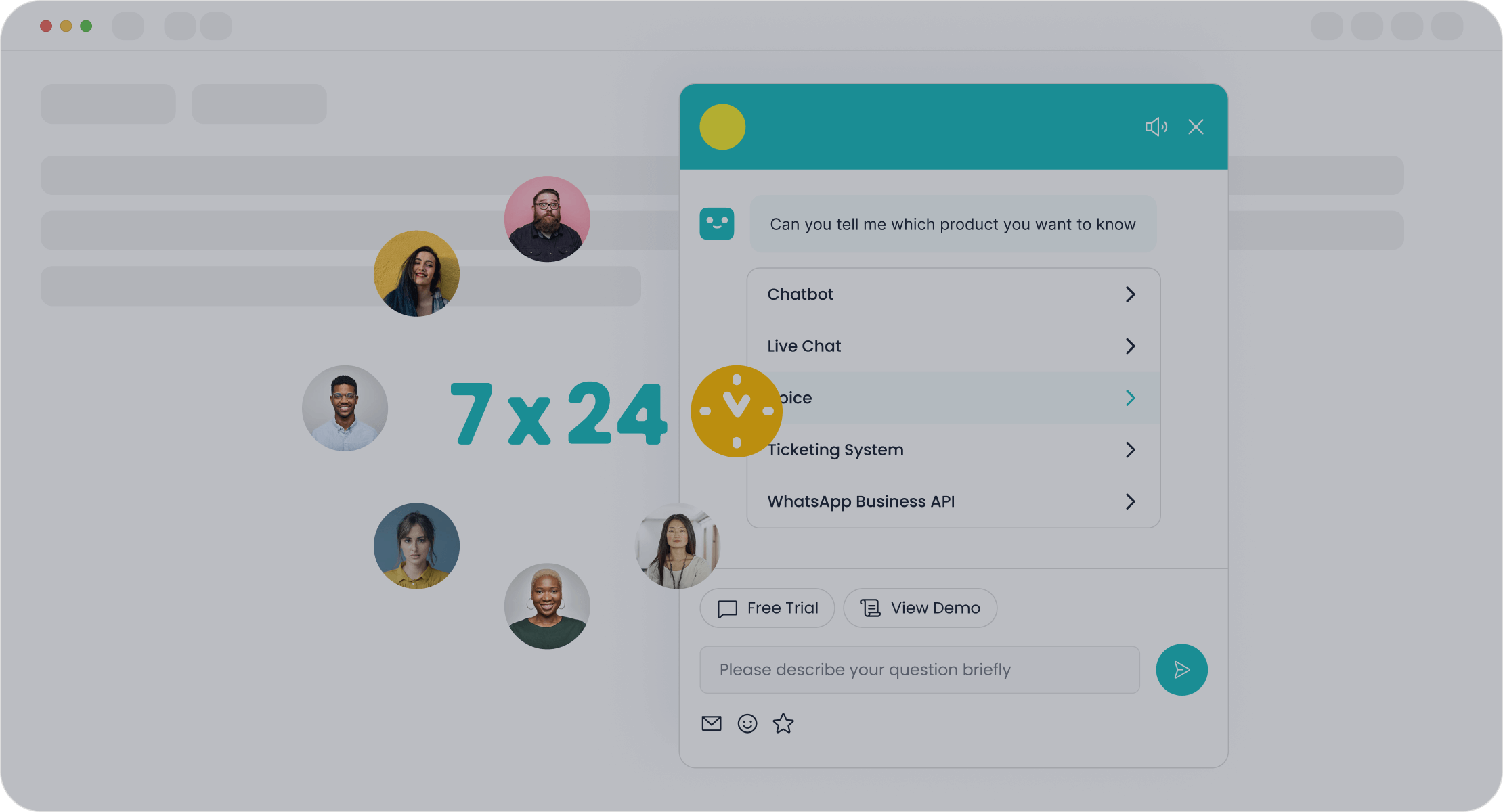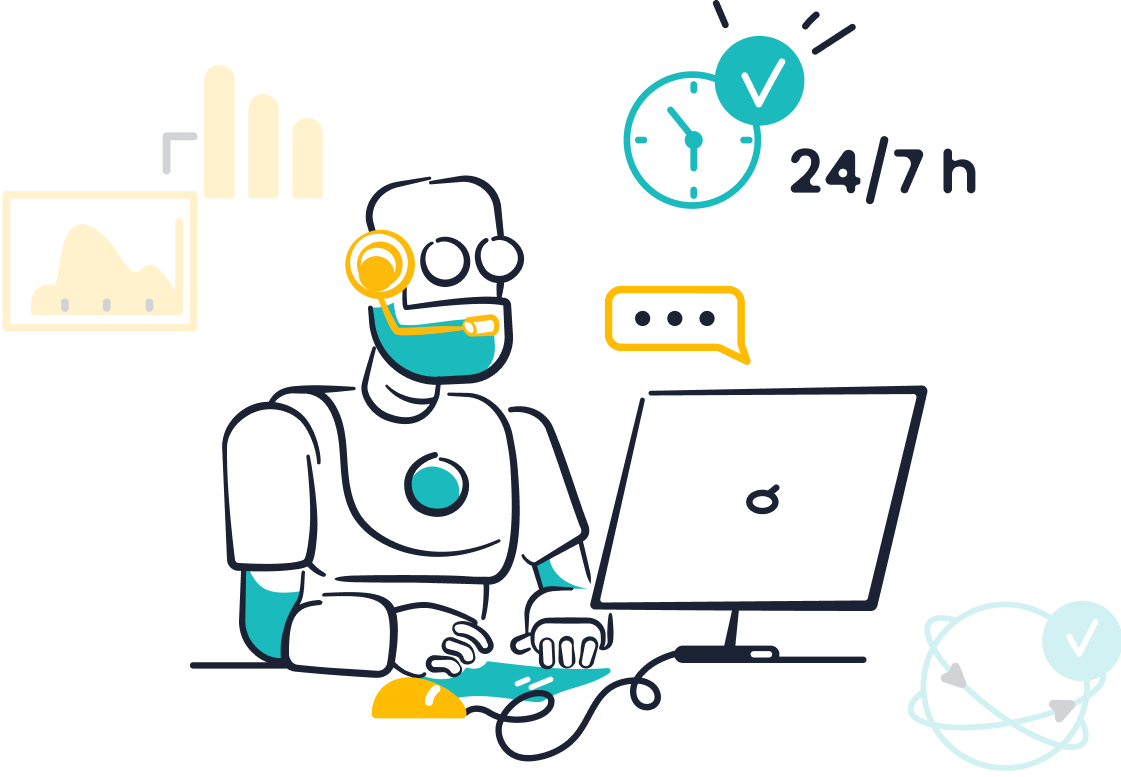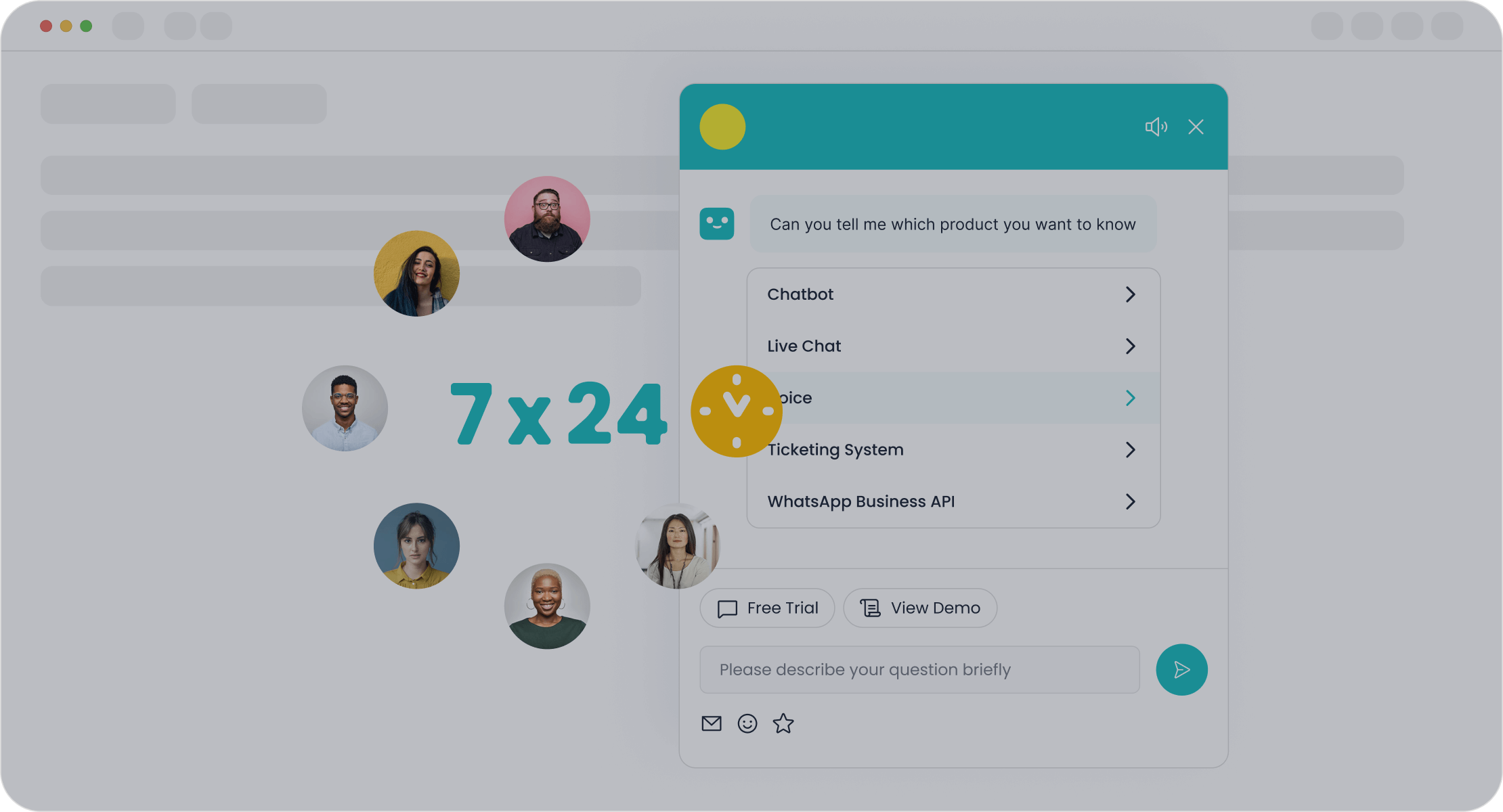How Chatbots Affect Customer Satisfaction and Service Quality

Chatbots are transforming how you experience customer service. They provide instant responses, operate 24/7, and reduce wait times, making interactions faster and more efficient. For example, 88% of consumers used chatbots in 2022 and 2023, with 87.2% reporting positive or neutral experiences. However, it's important to consider the disadvantages of chatbots in customer service, such as their limitations in handling complex queries. Despite these challenges, businesses like Samsung have achieved a 97% customer satisfaction rate by integrating advanced solutions like Sobot's AI Chatbot. This tool automates routine queries, saving up to 50% on costs while boosting productivity by 70%. With chatbots, you can enjoy seamless, personalized support that enhances your overall experience.
Understanding Chatbots and Their Role in Customer Service
What Are Chatbots? A Definition
Chatbots are software programs designed to simulate human conversations through text or voice. They play a vital role in customer service by answering questions, resolving issues, and even assisting with purchases. These tools ensure 24/7 availability, allowing businesses to meet customer needs at any time.
"A chatbot is essentially a piece of software that can mimic human conversations. In customer service, a chatbot can answer customer queries or even help make sales on e-commerce websites."
Chatbots have transformed customer service by automating routine tasks. This shift allows human agents to focus on complex issues, improving efficiency and service quality. For example, Delta Airlines’ “Ask Delta” chatbot has significantly reduced wait times, while Maruti Suzuki’s AI chatbot has handled millions of queries and facilitated thousands of bookings.
Types of Chatbots in Customer Support
Customer service chatbots come in various forms, each designed to address specific customer needs. Here’s a breakdown:
| Type of Chatbot | Description |
|---|---|
| Scripted or quick reply chatbots | Follow predefined decision trees to answer basic questions. |
| Menu-driven chatbots | Use a list of options to guide users toward solutions. |
| Keyword recognition chatbots | Respond based on keywords but may struggle with repetitive queries. |
| Hybrid chatbots | Combine menu-based and keyword recognition for better interaction. |
| Contextual chatbots | Use AI to remember past interactions and improve responses over time. |
| Voice-enabled chatbots | Allow voice-based interactions, like Amazon Alexa or Apple Siri. |
These types cater to different customer needs, from simple inquiries to more personalized and context-aware interactions.

How AI Chatbots Like Sobot's Enhance Customer Experience
AI chatbots, such as Sobot's, elevate customer experience by combining advanced technology with user-friendly features. Sobot's chatbot operates 24/7, ensuring you receive support whenever needed. Its multilingual capabilities break language barriers, while its no-coding-required setup makes it accessible for businesses of all sizes.
Sobot’s AI chatbot also personalizes interactions by analyzing customer data. This approach not only speeds up responses but also ensures your preferences are considered. For instance, 62% of users believe AI can cater to specific preferences, and 64% of businesses expect digital assistants to enhance personalized support.
By automating routine tasks, Sobot’s chatbot allows human agents to focus on complex issues. This balance improves efficiency and ensures you receive high-quality service. Additionally, its proactive messaging and real-time assistance boost conversions by 20%, making it a valuable tool for businesses aiming to enhance customer satisfaction.
How Chatbots Improve Customer Satisfaction

Instant Responses and 24/7 Availability
Chatbots revolutionize customer service by offering instant responses and round-the-clock availability. Unlike traditional customer support, which often operates within limited hours, chatbots remain active 24/7. This ensures you can access help whenever you need it, whether it’s during a busy workday or late at night. For instance, AI chatbots provide real-time responses, eliminating the frustration of waiting for assistance. They also handle unlimited interactions simultaneously, ensuring no drop in service quality during peak times.
The benefits of this constant availability are clear. In 2021, chatbot interactions surged by 2,350% compared to 2019, reflecting their growing role in customer support. Customers appreciate the agility and accessibility of automated services, which directly enhance customer satisfaction. With tools like Sobot’s AI chatbot, you can enjoy seamless support across multiple channels, ensuring your needs are met promptly and efficiently.
Personalization Through AI and Data Insights
Personalized interactions are key to elevating customer experience. Chatbots achieve this by leveraging data-driven insights to tailor responses based on your preferences and past interactions. For example, Sobot’s AI chatbot uses advanced AI to analyze customer data, ensuring every interaction feels relevant and meaningful. This approach not only improves efficiency but also fosters customer loyalty by making you feel valued.
Research shows that personalized experiences significantly enhance customer satisfaction. Chatbots excel in this area by remembering your preferences and providing tailored solutions. Imagine receiving proactive assistance or recommendations that align perfectly with your needs. This level of personalization transforms routine interactions into memorable experiences, strengthening your connection with the brand.
Reducing Wait Times and Enhancing Customer Support
Long wait times can frustrate customers and harm their perception of a brand. Chatbots address this issue by managing up to 80% of routine inquiries, freeing human agents to focus on complex problems. This reduces wait times and ensures you receive timely support. By the end of 2024, chatbots are expected to save 2.5 billion work hours, highlighting their efficiency in customer service.
Sobot’s chatbot exemplifies this capability by automating repetitive tasks and streamlining workflows. Whether you’re seeking quick answers or detailed assistance, the chatbot ensures your concerns are addressed promptly. This not only improves your overall experience but also enhances the quality of customer support. Faster resolutions lead to higher satisfaction, making chatbots an essential tool for improving customer satisfaction.
Boosting Conversions with Proactive Assistance
Proactive assistance is a game-changer in improving your customer experience and driving conversions. Chatbots excel in this area by engaging with you at the right moment, offering tailored support that guides you through your journey. For instance, if you spend time browsing a product page, a chatbot can step in to provide detailed information or suggest similar items. This timely interaction not only enhances your experience but also increases the likelihood of completing a purchase.
Proactive chatbots also integrate seamlessly with CRM systems, creating a unified flow of data. This integration allows businesses to understand your preferences and past interactions better. Sales teams can then use this information to offer personalized solutions, making you feel valued and understood. Such tailored approaches significantly improve conversion rates, as they align with your specific needs.
Sobot’s AI chatbot takes proactive assistance to the next level. It uses real-time intent analysis to identify when you might need help, ensuring you receive support before you even ask for it. This feature not only boosts your confidence in the brand but also streamlines your decision-making process. Additionally, Sobot’s chatbot operates across multiple channels, ensuring you receive consistent and proactive support wherever you interact with the business.
Studies show that proactive engagement can dramatically improve conversion rates. By addressing your concerns promptly and offering relevant suggestions, chatbots create a seamless and satisfying customer experience. This approach not only enhances customer satisfaction but also strengthens your trust in the brand, making you more likely to return for future purchases.
The Impact of Chatbots on Service Quality
Enhancing Efficiency and Speed of Customer Service
Chatbots have revolutionized customer service by significantly improving efficiency and response speed. They handle routine queries autonomously, allowing human agents to focus on complex issues. This division of tasks ensures faster resolutions and enhances the overall quality of customer support. For example, in 2021, chatbots managed 400 million interactions, a staggering 2,350% increase from 2019. This growth highlights their ability to streamline customer interactions effectively.
Operational metrics further demonstrate the efficiency of chatbots. Between 2019 and 2021, the problem-solving index rose from 77% to 92%, reflecting a 19% improvement in resolving customer concerns. Additionally, customer satisfaction ratings averaged 3.9 out of 5, with over 70% of users rating their experiences as excellent. These figures underscore how chatbots enhance the speed and quality of customer service, ensuring you receive timely and accurate assistance.
Scalability for High-Volume Customer Support
Scalability is a critical advantage of chatbots in customer support. They can manage a high volume of inquiries simultaneously, ensuring consistent service quality even during peak times. Unlike human agents, chatbots operate 24/7, providing uninterrupted support regardless of time zones or business hours. This capability makes them indispensable for businesses handling large-scale customer interactions.
For instance, in 2021, 15.9 million customers used virtual assistants, a 1,590% increase from 2019. This growth demonstrates how chatbots scale effectively to meet rising demand. By automating repetitive tasks, they free up resources, allowing businesses to allocate human agents to more complex issues. This balance ensures you receive efficient and personalized support, even during high-demand periods.
Consistency and Accuracy in Delivering Information
Chatbots excel in delivering consistent and accurate information, which is vital for maintaining trust in customer service. They rely on pre-programmed knowledge bases and AI algorithms to provide precise answers to your queries. This consistency eliminates the risk of human error and ensures you receive reliable information every time.
Quality assurance plays a crucial role in maintaining chatbot accuracy. Systematic testing and evaluation ensure chatbots meet high standards, enhancing both customer experience and operational efficiency. For example, chatbots undergo rigorous testing to ensure they deliver accurate and reliable interactions. This process fosters user trust and ensures a positive experience during customer interactions.
By integrating chatbots like Sobot’s AI-powered solution, businesses can achieve unparalleled consistency in customer support. Sobot’s chatbot uses advanced AI to analyze data and provide accurate responses across multiple channels. Its multilingual capabilities further enhance its reliability, ensuring you receive consistent support in your preferred language.
Cost-Effectiveness of AI Chatbots in Customer Service
AI chatbots have become a game-changer for businesses aiming to optimize customer service operations while reducing costs. By automating routine tasks, chatbots save time and resources, allowing companies to allocate their budgets more effectively. For instance, chatbots can handle up to 80% of repetitive inquiries, significantly cutting down the need for additional human agents.
The financial benefits of chatbots are evident across industries. A recent study revealed that businesses using AI chatbots reduced customer support costs by 30% and saved $1.3 million annually. Additionally, these tools are projected to cut agent labor costs by $80 billion by 2026. This cost efficiency makes chatbots an attractive solution for businesses of all sizes.
| Statistic Description | Value |
|---|---|
| Reduction in customer support costs | 30% |
| Savings from AI deployment | $1.3 million |
| Projected cut in agent labor costs (2026) | $80 billion |
| Revenue increase due to AI adoption | 32% |
Chatbots also improve operational efficiency by resolving tickets faster. Studies show that AI-powered systems can resolve 52% of tickets more quickly, saving businesses valuable time. This efficiency not only reduces costs but also enhances the overall quality of customer service.

Sobot’s AI chatbot exemplifies this cost-effectiveness. It operates 24/7, autonomously handling queries and saving up to 50% on additional agent costs. Its no-coding-required setup further reduces implementation expenses, making it accessible for businesses without technical expertise. By integrating Sobot’s chatbot, companies can achieve a 70% boost in productivity while cutting service costs significantly.
The scalability of chatbots also contributes to their cost-effectiveness. They can manage high volumes of inquiries simultaneously, ensuring consistent service quality without the need for extra staff. This capability is particularly valuable during peak seasons or promotional events, where customer interactions often surge.
Incorporating chatbots into your customer service strategy not only reduces expenses but also drives revenue growth. Businesses adopting AI solutions have reported a 32% increase in revenue, highlighting the dual benefits of cost savings and enhanced profitability. By leveraging tools like Sobot’s AI chatbot, you can achieve these outcomes while delivering exceptional customer experiences.
Addressing the Disadvantages of Chatbots in Customer Service
Overcoming the Lack of Human Empathy
One of the main disadvantages of chatbots in customer service is their inability to replicate human empathy. While chatbots excel at providing quick responses, they often fail to understand the emotional context of your concerns. This can lead to frustration, especially during sensitive situations. For instance, users have reported feeling anger or betrayal when chatbots offer overly generic or insincere responses.
To address this, businesses can implement a hybrid model. Chatbots can handle routine inquiries, while human agents step in for emotionally charged or complex issues. This approach ensures you receive the empathy and understanding only a human can provide. Sobot’s AI chatbot, for example, gathers initial information and seamlessly transfers the conversation to a human agent when needed. This collaboration enhances the overall quality of customer service, ensuring your concerns are addressed with care and precision.
Managing Technical Issues and Miscommunication
Technical issues and miscommunication are common challenges in chatbot deployments. Chatbots sometimes struggle to understand your queries, provide irrelevant information, or request excessive personal data. These issues can disrupt your experience and reduce trust in the service. For example, users often report frustration when chatbots repeat information already available on a company’s website.
To minimize these problems, businesses must invest in robust technical infrastructure. Developers should integrate chatbot scripts into website backends and configure APIs for real-time data retrieval. This ensures chatbots provide accurate and timely responses. Sobot’s chatbot exemplifies this by operating across multiple platforms with a strong technical foundation, ensuring smooth and reliable interactions. Regular updates and testing also play a crucial role in maintaining chatbot performance and reducing errors.
"LLM chatbot evaluation differs from standard LLM evaluation as it assesses the quality of responses in the context of prior conversation history, requiring specific metrics tailored for conversational interactions."
Balancing Automation with Human Interaction
Striking the right balance between automation and human interaction is essential for effective customer service. Chatbots are excellent for handling standard inquiries and FAQs, but they may fall short when dealing with complex or emotionally sensitive issues. Users often feel more satisfied when human agents provide personalized support for these situations.
A successful model involves chatbots initiating interactions by collecting relevant data and human agents stepping in for final resolutions. This teamwork ensures you receive comprehensive support. For example, Sobot’s AI chatbot uses decision trees to gather initial information, allowing human agents to focus on delivering tailored solutions. This balance not only improves efficiency but also enhances your overall experience by combining the speed of automation with the empathy of human interaction.
Ensuring Chatbots Handle Complex Queries Effectively
Handling complex queries is one of the biggest challenges for chatbots in customer service. While chatbots excel at managing routine tasks, they often require advanced strategies to address intricate customer concerns effectively. You can ensure better performance by combining AI capabilities with human oversight and continuous improvement.
AI chatbots like Sobot’s are designed to handle complex queries by leveraging advanced technologies. They use a robust knowledge base built from diverse sources, such as articles and PDFs, to provide accurate and detailed responses. For example, Sobot’s chatbot integrates seamlessly with customer-preferred platforms like WhatsApp and SMS, ensuring consistent service quality across channels. When a query exceeds the chatbot’s capabilities, it escalates the issue to a human agent, ensuring you receive the support you need without delays.
To improve chatbot performance, businesses should focus on three key areas:
- Interactive Learning: Simulated conversations help chatbots refine their problem-solving skills. This training ensures they can handle more nuanced customer interactions.
- Continuous Updates: Regularly updating the chatbot’s knowledge base keeps it relevant and accurate. This step ensures you receive up-to-date information during interactions.
- Human Oversight: Complex queries should always be escalated to human agents. This approach ensures that your concerns are addressed with empathy and precision.
Additionally, businesses can implement a feedback loop to enhance chatbot functionality. Collecting and analyzing user feedback helps identify areas for improvement. Iterating on this feedback ensures the chatbot evolves to meet your needs better. For instance, Sobot’s AI chatbot uses real-time data insights to refine its responses, improving customer satisfaction and service quality.
By integrating AI tools into the escalation process, businesses can streamline workflows and improve efficiency. This combination of automation and human expertise ensures chatbots deliver high-quality support, even for complex issues. With tools like Sobot’s, you can enjoy seamless, accurate, and personalized customer service that meets your expectations.
Best Practices for Implementing Chatbots Like Sobot's

Identifying the Right Use Cases for AI Chatbots
To maximize the benefits of chatbots, you need to identify the right use cases for their deployment. Start by analyzing your customer support needs. Determine which tasks are repetitive and time-consuming, such as answering FAQs or processing simple inquiries. These are ideal for automation. For example, Sobot’s AI chatbot excels at handling routine queries, freeing agents to focus on complex issues.
Consider scalability and future growth. Choose a chatbot solution that meets immediate goals but adapts to evolving customer service demands. Sobot’s chatbot integrates seamlessly with omnichannel platforms, ensuring consistent support across channels like WhatsApp and SMS. This adaptability makes it suitable for businesses of all sizes.
Other best practices include:
- Conducting customer research to understand preferences and pain points.
- Ensuring integration with existing tools like CRM systems for streamlined workflows.
- Prioritizing clear and friendly communication to enhance user experience.
By following these steps, you can deploy chatbots effectively, improving customer satisfaction and operational efficiency.
Combining Chatbots with Human Customer Support
A hybrid model combining chatbots with human agents ensures comprehensive customer support. Chatbots handle routine tasks, while human agents address complex or emotionally sensitive issues. This collaboration enhances service quality and customer satisfaction.
| Feature/Benefit | Description |
|---|---|
| Seamless Transition | Chatbots transfer unresolved queries to human agents, maintaining context. |
| Customer Satisfaction | Quick AI responses paired with human empathy reduce frustration. |
| Cost Efficiency | Automating routine tasks lowers costs by up to 30%. |
| 24/7 Availability | Chatbots provide round-the-clock support, boosting brand loyalty. |
| Adaptability | Hybrid models combine rule-based automation with AI-driven flexibility. |
Sobot’s chatbot exemplifies this approach. It gathers initial data and escalates complex queries to human agents, ensuring you receive personalized and efficient support. This balance improves productivity and strengthens customer relationships.
Regular Updates and Training for Chatbots
Regular updates and training keep chatbots relevant and effective. You need to assess performance frequently and identify areas for improvement. For example, Sobot’s chatbot uses real-time data insights to refine its responses, ensuring accuracy and relevance.
Key practices include:
- Assessing training needs based on customer interaction data.
- Using role-playing scenarios to simulate real-world situations.
- Updating the chatbot’s knowledge base to align with evolving industry standards.
- Monitoring performance to reinforce skills and eliminate errors.
These steps ensure your chatbot handles diverse scenarios and complex queries effectively. By investing in continuous improvement, you enhance customer support and maintain high service quality.
Monitoring Performance and Gathering Customer Feedback
Monitoring chatbot performance and gathering customer feedback are essential for maintaining high-quality customer service. By analyzing interactions and tracking key metrics, you can identify areas for improvement and ensure your chatbot delivers a seamless experience.
Key Metrics to Monitor
To evaluate chatbot performance effectively, focus on these critical metrics:
- Knowledge Base Response Rate: Measure how often the chatbot provides accurate answers from its knowledge base.
- Containment Rate: Track the percentage of queries resolved without human intervention.
- Gap Analysis: Identify missing information in the knowledge base to refine training and improve responses.
Regularly simulating queries can also help uncover weaknesses before they affect real interactions. This proactive approach ensures your chatbot remains reliable and efficient.
Tools for Performance Tracking
Advanced tools like Dimension Labs offer features to monitor chatbot performance:
| Feature | Description |
|---|---|
| Metrics Tracking | Tracks key performance indicators to evaluate chatbot effectiveness. |
| Customizable Dashboards | Allows you to create dashboards for monitoring changes and receiving alerts. |
| Reporting | Provides detailed reports to identify underperformance factors. |
These tools simplify performance evaluation, enabling you to make data-driven decisions.
Gathering Customer Feedback
Customer feedback is invaluable for refining chatbot services. Use post-chat surveys or ratings to collect insights into user satisfaction. For example, Sobot’s AI chatbot integrates feedback mechanisms seamlessly, allowing you to gather actionable data. This feedback loop helps you understand customer expectations and adapt your chatbot to meet them.
By combining performance monitoring with customer feedback, you can enhance your chatbot’s capabilities and ensure it continues to deliver exceptional customer service.
Chatbots have transformed how you interact with businesses, offering instant, scalable, and cost-effective solutions. Tools like Sobot's AI Chatbot enhance your customer experience by providing personalized, 24/7 support while reducing response times. In 2021, chatbots handled 400 million interactions, a 2,350% increase from 2019, showcasing their growing role in customer service. They also improved the problem-solving index from 77% to 92%, ensuring higher service quality. By automating routine tasks, chatbots allow human agents to focus on complex issues, creating a seamless customer experience.
While challenges like handling complex queries exist, businesses can overcome them by integrating chatbots with human support and following best practices. This approach ensures you receive efficient, empathetic, and accurate assistance. By leveraging chatbots effectively, companies can build stronger relationships, improve customer experiences, and achieve operational excellence.
FAQ
What industries benefit the most from chatbots?
Chatbots improve customer satisfaction across industries like retail, finance, gaming, and education. For example, Sobot’s AI chatbot helps retail businesses handle high-volume inquiries during sales events, ensuring quick responses and better service quality. In finance, chatbots guide customers through complex processes, enhancing efficiency and trust.
How do chatbots reduce customer service costs?
Chatbots automate repetitive tasks, reducing the need for additional agents. Sobot’s AI chatbot operates 24/7, saving up to 50% on staffing costs. Businesses also save time by resolving 80% of routine queries instantly, allowing human agents to focus on complex issues.
Can chatbots handle multiple languages?
Yes, many chatbots, including Sobot’s, support multilingual interactions. This feature ensures you receive assistance in your preferred language, breaking communication barriers and improving customer satisfaction. For example, Sobot’s chatbot supports global businesses by offering seamless service in over 20 languages.
Are chatbots secure for customer interactions?
Chatbots prioritize security by encrypting data and adhering to privacy regulations. Sobot’s AI chatbot ensures safe interactions by integrating with secure platforms like WhatsApp Business API. This approach builds trust and protects sensitive customer information during every interaction.
How do chatbots improve customer satisfaction?
Chatbots enhance satisfaction by providing instant responses, 24/7 availability, and personalized support. Sobot’s chatbot uses AI to analyze customer data, offering tailored solutions that meet your needs. This proactive approach reduces wait times and creates a seamless experience, boosting overall service quality.
See Also
Enhancing E-commerce Satisfaction Through Effective Chatbot Solutions
Key Advantages of Integrating Chatbots on Your Website
Ten Strategies to Improve Live Chat Customer Experience
Increasing Operational Efficiency with AI Customer Service Tools